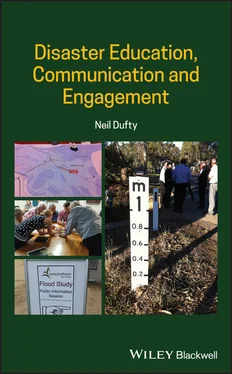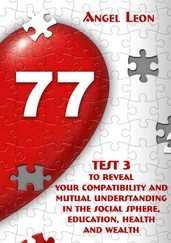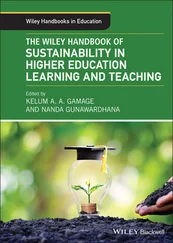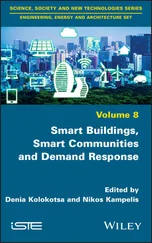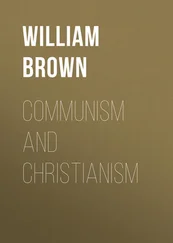| Education |
Communication |
Engagement |
| Informal education |
One-way communication |
Inform |
| Incidental education |
Two-way communication |
Involve |
| Formal education |
|
Consult |
| Non-formal education |
Collaborate |
|
Empower |
The benefits of a combined Disaster ECE approach, although appearing to be conceptually valid, have only been once directly tested through the literature. The research from Kelly and Ronan (2018) proposed that what may be most effective in disaster preparedness is not education or engagement per se, but a combination of the two. The role of social media was additionally considered in this research, given the proposal (Dufty 2012) that social media provides a good platform for a convergence of engagement and educational influences.
The research tested the education and engagement model for disaster preparedness and found that ‘whilst the model was significant, the variables that added unique predictor ability were individual factors rather than a composite of individual, community, and institutional factors as found in previous research’. Also, ‘disaster preparedness messages can be conveyed either by traditional media or social media. There was no difference in whether actions were taken nor was there any difference in confidence and trust in the types of media. Given the low cost of social media campaigns, pending replication of current findings, consideration should be given to its use over traditional media.’
Further research is required to test the effectiveness of a combined ECE approach by emergency agencies and other organisations. However, the approach is promoted in this book due to its promise in providing cumulative benefits.
1 Arnstein, S.R. (1969). A ladder of citizen participation. Journal of the American Institute of Planners 35: 216–224.
2 Australian Emergency Management Institute (2013). National Strategy for Disaster Resilience: Community Engagement Framework (Handbook 6). Commonwealth of Australia.
3 Australian Red Cross (2010). Communicating in recovery. Available: https://www.redcross.org.au/getmedia/489d9553-fcdc-4ad6-929c-8413882a4fca/Communicating-in-recovery-resource.pdf.aspx.
4 Begg, C., Ueberham, M., Masson, T., and Kuhlicke, C. (2016). Interactions between citizen responsibilization, flood experience and household resilience: insights from the 2013 flood in Germany. International Journal of Water Resources Development 33 (4): 591–608.
5 Choi, S.O. and Brower, R.S. (2006). When practice matters more than government plans a network analysis of local emergency management. Administration and Society 37: 651–678.
6 Coen, D.R. (2012). The Earthquake Observers: Disaster Science from Lisbon to Richter. Chicago: University of Chicago Press.
7 Cope, S., Frewer, L.J., Houghton, J. et al. (2010). Consumer perceptions of best practice in flood risk communication and management: implications for risk analysis policy. Flood Policy 35 (4): 349–357.
8 Council of Australian Governments (2011). National Strategy for Disaster Resilience. Commonwealth of Australia.
9 Craft, M. (1984). Education and Cultural Pluralism. London, UK: Falmer.
10 Demeritt, D. and Nobert, S. (2014). Models of best practice in flood risk communication and management. Environmental Hazards 13: 313–328.
11 Dufty, N. (2011). Engagement or education? Australian Journal of Emergency Management 26 (3): 35–39.
12 Dufty, N. (2012). Using social media to build community disaster resilience. Australian Journal of Emergency Management 27: 40–45.
13 Dufty, N. (2013). The place of education in building disaster resilience: a strategic examination. Molino Stewart occasional papers. Available: http://works.bepress.com/neil_dufty/28.
14 Dufty, N. (2016). A society-first approach to flood mitigation. 56th Floodplain Management Australia Conference. Available: http://works.bepress.com/neil_dufty/46/(accessed 19 June 2019).
15 Eiser, J.R., Bostrom, A., Burton, I. et al. (2012). Risk interpretation and action: a conceptual framework for responses to natural hazards. International Journal of Disaster Risk Reduction: Vol. 1, 5–Vol. 1, 16.
16 Eitzel, M.V., Cappadonna, J.L., Santos-Lang, C. et al. (2017). Citizen science terminology matters: exploring key terms 2017 citizen science terminology matters: exploring key terms. Citizen Science: Theory and Practice 2 (1): 1–20.
17 Feng, S., Hossain, L., and Paton, D. (2018). Harnessing informal education for community resilience. Disaster Prevention and Management 27 (1): 43–59.
18 Fischhoff, B. (1995). Risk perception and communication unplugged: twenty years of process. Risk Analysis 15 (2): 137–146.
19 Freeman, R. (1984). Stakeholder Management: A Strategic Approach. New York: Pitman.
20 Frewer, L.J. and Salter, B. (2007). Societal trust in risk analysis: implications for the interface of risk assessment and risk management. In: Trust in Cooperative Risk Management. Uncertainty and Scepticism in the Public Mind (eds. M. Siegrist, T.C. Earle and H. Gutscher). London: 142–158. Earthscan.
21 Government of Australia (2014). Communication and complex emergencies: a resource guide. Available: https://reliefweb.int/sites/reliefweb.int/files/resources/Communication-and-Complex-Emergencies-Resource-Guide.pdf.
22 Gunawan, I. (2013). Using Participatory Mapping for Disaster Preparedness in Jakarta. GFDRR-World Bank.
23 Hager, P. (2001). Lifelong learning and the contribution of informal learning. In: International Handbook of Lifelong Learning (eds. D. Aspin, J. Chapman, M. Hatton and Y. Sawano), 79–92. Dordrecht: Springer.
24 Hannides, T. (2015). Humanitarian Broadcasting in Emergencies: A Synthesis of Evaluation Findings. Research Report, Issue 7, BBC Media Action.
25 Haworth, B.T. (2016). Assessing the potential, application, and implications of volunteered geographic information in disaster risk reduction. A thesis submitted in fulfilment of the requirements for the degree of Doctor of Philosophy in the Faculty of Science School of Geosciences, University of Sydney.
26 Haworth, B.T., Bruce, E., Whittaker, J., and Read, R. (2018). The good, the bad, and the uncertain: contributions of volunteered geographic information to community disaster resilience. Frontiers in Earth Science 6: 183.
27 Hodgson, R.W. (2007). Emotions and sense making in disturbance: community adaptation to dangerous environments. Human Ecology Review 14 (2): 233–242.
28 Holley, R. (2010). Crowdsourcing: how and why should libraries do it? D-Lib Magazine, Vol. 16, No. 3, n.p.
29 Howe, J. (2006). The rise of crowdsourcing. Wired, Issue 14.06, 1–4.
30 IAP2 (2019). Public participation spectrum. [Online]. Available: www.iap2.org.au/About-Us/About-IAP2-Australasia-/Spectrum(accessed 19 June 2019).
31 International Federation of Red Cross and Red Crescent Societies (2009). World Disaster Report. Focus on Early Warning, Early Action. Available: https://www.ifrc.org/en/publications-and-reports/world-disasters-report/wdr2009/.
32 International Federation of Red Cross and Red Crescent Societies (2014a). Early warning early action mechanisms for rapid decision making: drought preparedness and response in the arid and semi-arid lands of Ethiopia, Kenya and Uganda, and in the East Africa Region. Available: https://www.ennonline.net/attachments/2160/Early-Warning-Early-Action-Report-Final-July-2014.pdf.
33 International Federation of Red Cross and Red Crescent Societies (2014b). World Disasters Report 2014: Focus on Culture and Risk. Available: https://www.ifrc.org/world-disasters-report-2014.
Читать дальше
